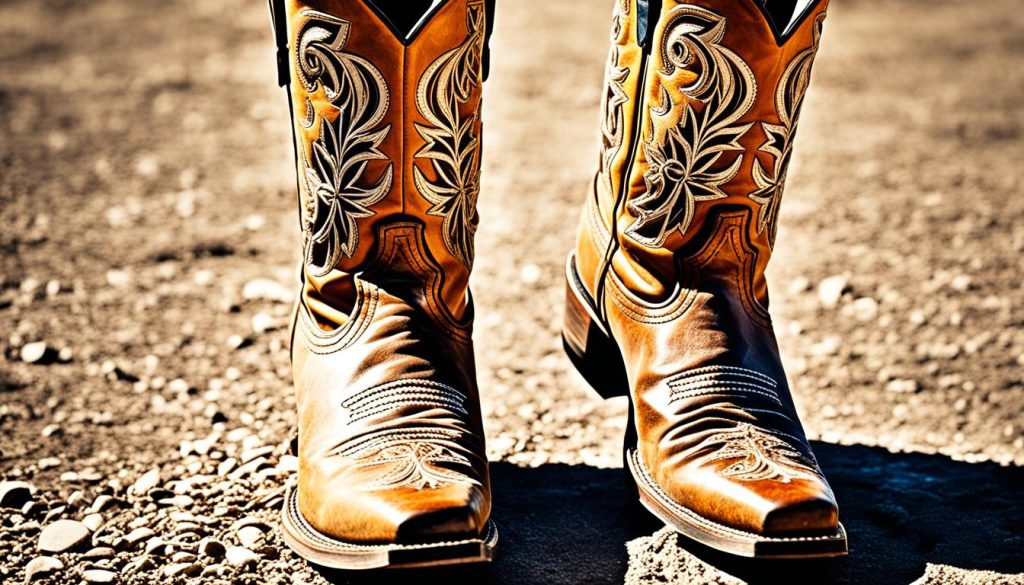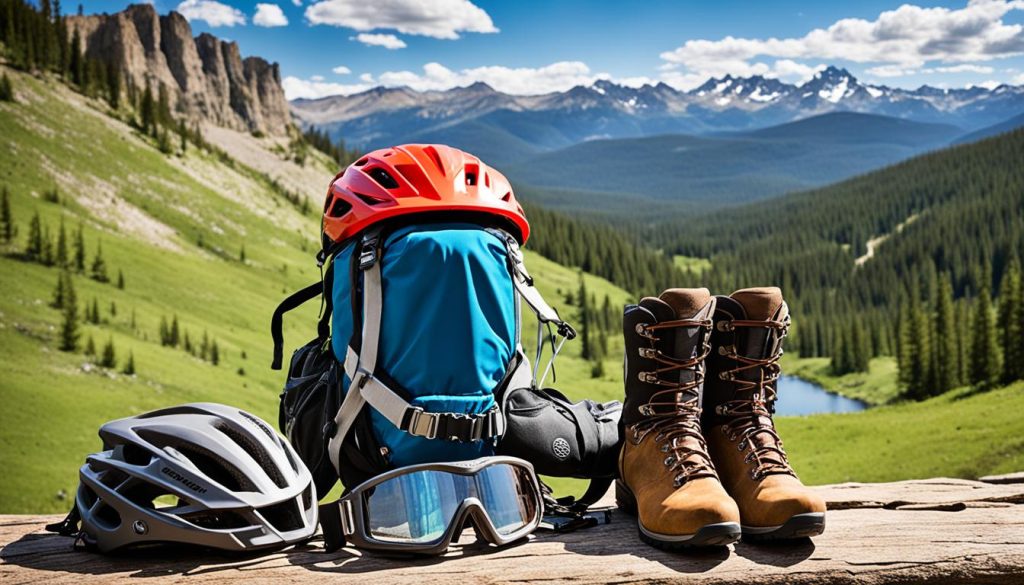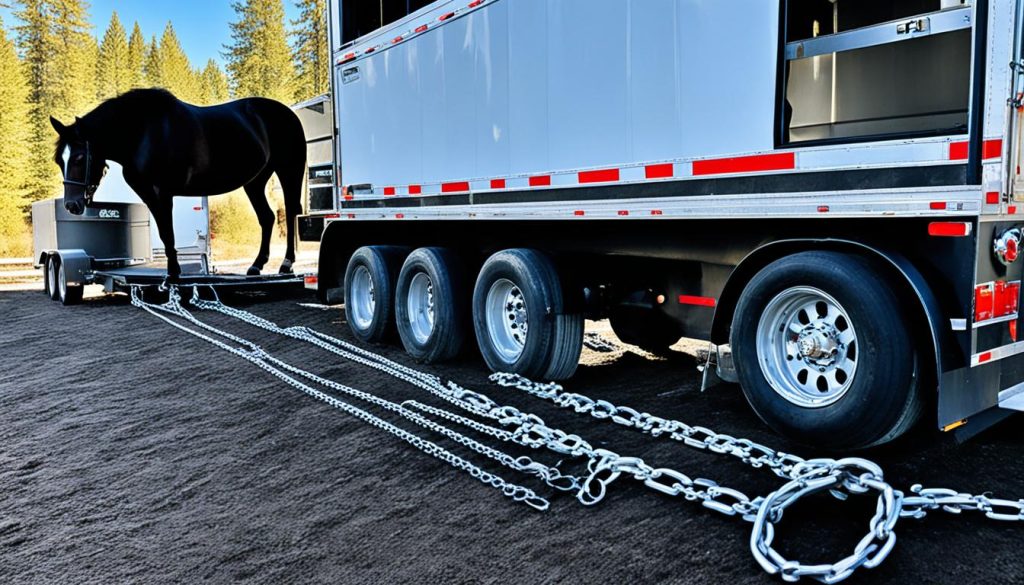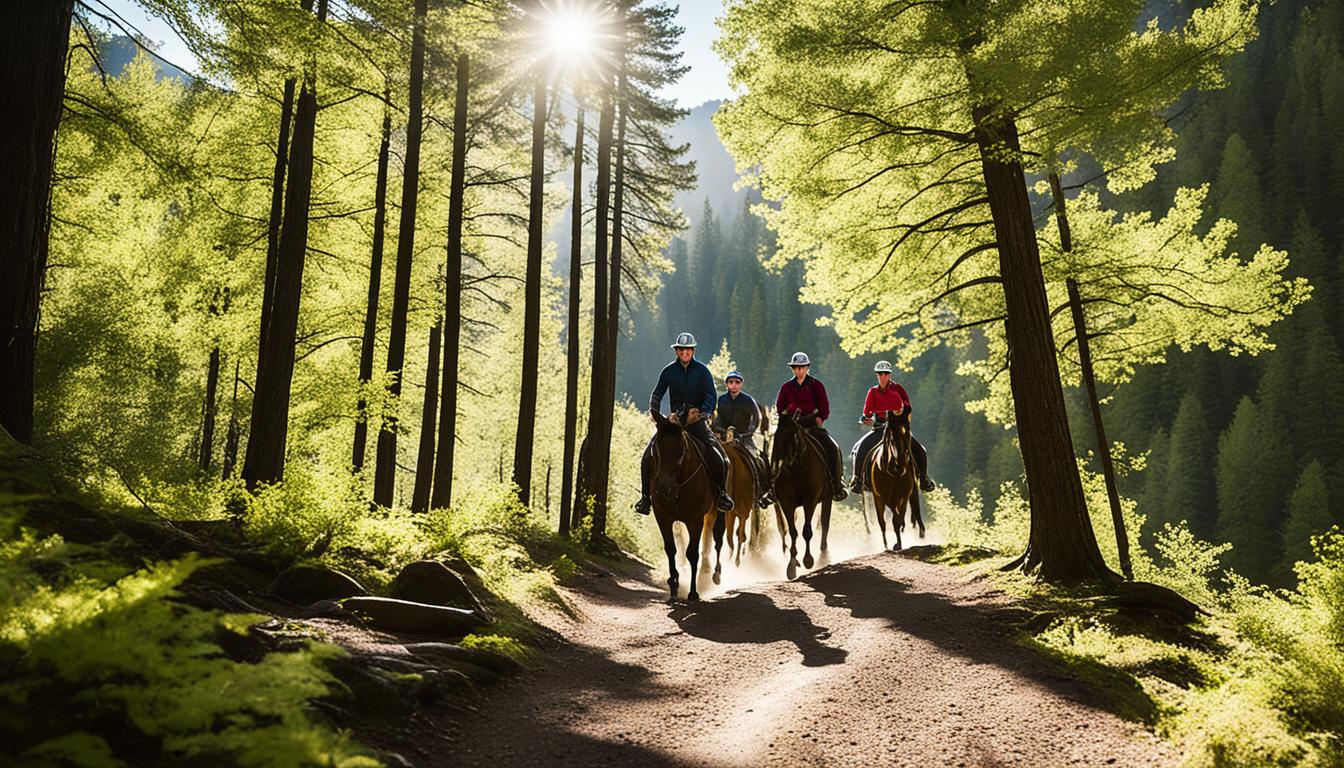Did you know that trail riding and outdoor training have become increasingly popular among adventure enthusiasts and nature lovers? With more than 7.2 million people participating in horseback riding and outdoor activities in the United States alone, it’s clear that the allure of wilderness exploration and adventure sports is irresistible.
Whether you’re an experienced rider or new to the world of trail riding, it’s important to have the right gear and knowledge to ensure a safe and enjoyable experience. In this article, we will provide you with essential tips and information to help you prepare for unforgettable trail riding and outdoor training excursions.
Key Takeaways:
- Trail riding and outdoor training have gained immense popularity among adventure enthusiasts and nature lovers.
- More than 7.2 million people participate in horseback riding and outdoor activities in the United States.
- Having the right gear and knowledge is essential for a safe and enjoyable trail riding experience.
- In this article, we will share essential tips and information to help you prepare for trail riding and outdoor training.
- Stay tuned to learn more about tapaderos, rider footwear, reins, must-have gear, and safety precautions for a successful trail ride.
The Importance of Tapaderos and Rider Footwear
When it comes to trail riding, safety should be your top priority. That’s why having the right gear, like tapaderos and rider footwear, is essential to ensure a secure and enjoyable riding experience.
Tapaderos: Protecting Your Feet in Rugged Terrains
If you’re not familiar with tapaderos, they are stirrup covers that fully enclose the stirrups. These protective covers play a vital role in preventing your foot from sliding all the way through in case of a fall or accident. Especially when riding through rugged terrains, tapaderos provide a significant safety advantage by keeping your feet secure and protected.
Investing in tapaderos as part of your trail riding equipment is crucial to minimize the risk of accidents and injuries. They are designed to withstand various trail conditions, ensuring your feet stay in place even during unexpected situations.
Choosing the Right Rider Footwear
In addition to tapaderos, the type of rider footwear you choose can significantly impact your safety and riding experience. Smooth-soled boots are recommended as they are less likely to hang up while dismounting, reducing the risk of accidents.
One popular choice among backcountry horsemen is lace-up packer boots. These boots provide stability, protection, and prevent slipping off the stirrups, allowing you to maintain control over your horse at all times.
When selecting rider footwear, look for durable materials and a comfortable fit. Proper footwear not only ensures your safety but also enhances your overall riding performance and enjoyment.

With the right gear, like tapaderos and appropriate rider footwear, you can embark on your trail riding adventures with confidence, knowing that you’ve taken the necessary precautions to stay safe. So, make sure to prioritize safety and invest in reliable trail riding equipment for a memorable and secure outdoor experience.
The Right Reins for Trail Riding
When venturing out on a trail ride, having the right reins is essential for maintaining control and ensuring a safe and enjoyable experience. So, what type of reins should you choose for trail riding? Smooth, light leather split reins are often the preferred option among experienced riders.
Split reins offer several advantages when it comes to trail riding. Firstly, they are comfortable to hold, allowing you to maintain a steady grip throughout your ride. The smooth leather construction ensures a soft and supple feel in your hands, reducing the risk of discomfort or chafing during long hours on the trail.
Moreover, split reins provide better control over your horse’s movements. With these reins, you can independently control each side of the horse, allowing for precise direction and adjustments when navigating tricky terrain or encountering unexpected obstacles. This level of control is crucial for maintaining balance and safety on the trails.
When choosing reins for trail riding, it’s important to avoid using rope-rein/mecate setups. While these setups may seem appealing due to their traditional aesthetics, they can pose a potential safety risk. Rope reins can become tangled or caught, compromising your ability to steer and control your horse effectively. Stick to the tried-and-true split reins for a safer and more reliable trail riding experience.
Remember, investing in the right trail riding equipment, such as suitable reins, is key to ensuring your safety and the welfare of your horse during outdoor adventures. So, before hitting the trails, evaluate your reins and opt for smooth, light leather split reins for a confident and secure ride.
| Pros of Smooth, Light Leather Split Reins for Trail Riding | Cons of Rope-Rein/Mecate Setups for Trail Riding |
|---|---|
| • Comfortable to hold | • Prone to tangling and getting caught |
| • Better control over your horse | • Less precise control |
| • Soft and supple feel | • Less reliable in challenging terrain |
| • Safer option for trail riding | • Potential safety risk |
Must-Have Gear for Trail Riding
Before heading out on a trail riding adventure, it’s essential to pack the necessary gear and supplies. Ensuring that you have the right trail riding gear, essential supplies, and safety equipment will not only make your ride more enjoyable but also provide peace of mind. Here’s a packing list of must-have items:
Tack
When it comes to tack, make sure you have the following essentials:
- Saddle
- Bridle
- Breastplate
- Cinch
- Saddlebags
- Saddle pad
Rider Gear
For your safety and comfort, pack these essential rider gears:
- Helmet
- Spurs
- Crop
- Protective legwear
Other Supplies
Don’t forget these essential supplies to ensure the well-being of both you and your horse:
- Water for your horse
- Hay for snacking
- First-aid kits for both humans and horses
- Grooming supplies
- Hoof pick
- Insect repellent
Additionally, consider carrying multi-tools for emergencies, extra reins for backup, treats for rewarding your horse, and rain gear to prepare for unexpected weather changes. These additional items will ensure you’re fully prepared for various situations that may arise during your trail riding adventure.

Having the right gear and essential supplies is crucial for a safe and enjoyable trail riding experience. Make sure to double-check your packing list and ensure that everything is in order before setting off on your trail ride. By being well-prepared, you can focus on the breathtaking nature around you and create lasting memories with your equine partner.
Preparing for a Safe Trail Ride
Before embarking on a trail ride, it’s important to take necessary precautions to ensure your safety and the well-being of your horse. Here are some essential steps to take and items to have in place before hitting the trail:
1. Trail Ride Planning
Effective trail ride planning is crucial for a safe and enjoyable experience. Research the trail you’ll be riding on and gather information about its difficulty level, terrain, and any potential hazards. Ensure that you have the appropriate trail maps and a clear understanding of the route.
2. Horse Trailer Safety
Inspecting your horse trailer before the ride is essential for both the safety of your horse and your own peace of mind. Check the condition of the trailer’s floor, undercarriage, braking system, wheels, tires, and hitch mechanism. Ensure that everything is in good working order and that there are no signs of damage or wear that could compromise the safety of the journey.
3. Paperwork and Documentation
Having the right paperwork and documentation is important for several reasons. Make sure you have all necessary registration papers, Coggins and health certificates for your horse, and any permits required for the trail. Additionally, keep a copy of the emergency equine roadside service phone number handy in case of any unexpected situations.
4. Safety Precautions
Take appropriate safety precautions to protect yourself and your horse during the ride. Wear a well-fitted helmet and suitable riding attire that provides ample protection. Consider investing in safety gear such as reflective clothing or accessories to enhance visibility, especially during low-light conditions. Additionally, always carry a fully stocked first-aid kit for both humans and horses and ensure you know how to use it.
5. Emergency Preparedness
Being prepared for emergencies is essential when going on a trail ride. Carry a portable charger or extra batteries for your phone in case you need to make an emergency call. Have a plan in place for communication and make sure someone else knows your trail riding plans and estimated return time. Also, consider carrying basic survival items such as matches, a pocket knife, and a whistle.
6. Packing and Gear Checklist
Properly pack your supplies and gear before heading out on the trail. Double-check that you have all essential items such as water and snacks for your horse, proper tack and saddlery equipment, grooming supplies, insect repellent, and rain gear. Remember to pack enough food and water for yourself as well, and consider carrying a GPS device or compass for navigation.

By following these trail ride planning, horse trailer safety, paperwork, safety precautions, and emergency preparedness tips, you can ensure a safe and enjoyable trail riding experience for both you and your horse. Taking the necessary steps to prepare and be equipped for any situation will allow you to fully enjoy the wonders of the great outdoors.
Conclusion
In conclusion, trail riding and outdoor training offer a multitude of opportunities for horseback riders and outdoor enthusiasts. These activities allow you to immerse yourself in nature, explore beautiful landscapes, and create unforgettable memories.
To ensure a safe and enjoyable experience, it is essential to follow safety guidelines and prioritize your well-being. Choose the right gear, including tapaderos, rider footwear, and comfortable split reins. Pack all the necessary supplies and equipment, such as tack, rider gear, and first-aid kits, to be prepared for any situation that may arise.
Remember that safety should always be your top priority. Take the necessary precautions, plan your trail ride in advance, and ensure your horse trailer is in optimal condition. By following these safety tips, you can embark on a trail riding adventure confidently.
Enjoy every moment of your outdoor training and trail riding experiences. Appreciate the wonders of nature, respect the environment, and cherish the bond between you and your horse. Get ready to gear up, make unforgettable memories, and embark on exciting adventures in the great outdoors.
